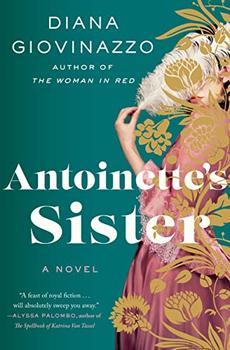Summary | Excerpt | Reading Guide | Reviews | Beyond the Book | Read-Alikes | Genres & Themes | Author Bio

This article relates to Antoinette's Sister
 The children of the Holy Roman Empress Maria Theresa form a large part of the cast of Antoinette's Sister by Diana Giovinazzo. This is no surprise: They numbered enough to make up a team roster for many sports, with 10 of 16 surviving to adulthood. Of these, the most famous are her sons Joseph II and Leopold II, both of whom inherited the Holy Roman Empire in turn; Maria Carolina, Queen of Naples and Sicily, around whom Antoinette's Sister revolves; and Marie Antoinette, Queen of France.
The children of the Holy Roman Empress Maria Theresa form a large part of the cast of Antoinette's Sister by Diana Giovinazzo. This is no surprise: They numbered enough to make up a team roster for many sports, with 10 of 16 surviving to adulthood. Of these, the most famous are her sons Joseph II and Leopold II, both of whom inherited the Holy Roman Empire in turn; Maria Carolina, Queen of Naples and Sicily, around whom Antoinette's Sister revolves; and Marie Antoinette, Queen of France.
Known for the educational reforms implemented during her reign and sometimes called "Europe's mother-in-law," Maria Theresa ensured her family's lasting political power by arranging for advantageous marriages between her children and the heirs and heiresses to thrones, regions or fortunes. Between the four children mentioned above, for example, Maria Theresa managed to ally Austria and the Holy Roman Empire with the kingdoms of Parma (through Joseph II's first wife, Isabella), Bavaria (through his second wife, Maria Josepha), Spain (Leopold II married the Infanta Maria Luisa), Naples and Sicily (joint kingdoms held by Maria Carolina's husband, Ferdinand IV), and France (through Marie Antoinette's marriage to the dauphin of France, who would later become Louis XVI).
Even though she herself had been granted a love match by her father, marrying the far lower-ranking Duke of Lorraine, Maria Theresa chose to politicize her children's marriages and remarriages. This forced her to abandon being a mother before an empress; instead, she had to think of the good of the Empire before their individual preferences and choices. In such a male-dominated world, one of the only ways that Maria Theresa could maintain her power — and guarantee that her children, and especially her daughters, could inherit some semblance of it — was by assuring their strategic marriages.
Although these marriage plans led to what may seem like some strange situations between the siblings (for example, Maria Carolina's elder sister Maria Josepha had initially been promised to Ferdinand IV, but Josepha died of smallpox before the marriage could take place), overall they formed a supportive coalition across the corners of Europe. In 1777, for example, Joseph II visited his youngest sister at Versailles, eager to see for himself whether their mother was exaggerating in her worry over Marie Antoinette's situation at court. Through his advice and instruction, Antoinette was reconciled with her husband — though this was a matter of national importance, it is clear to modern scholars that Joseph's relationship with his sister was filled with brotherly concerns and kindness.
Similarly, Leopold II (at the time the Grand Duke of Tuscany) helped Maria Carolina through the start of her marriage, which she publicly dreaded. Eventually the father of 16 children with his wife Maria Luisa — whose younger brother Ferdinand was the fiancé so loathed by Maria Carolina before their meeting — Leopold gave his sister advice and counsel similar to that of Joseph's to Antoinette. They remained close throughout their adulthoods, exchanging much correspondence, and they both feature heavily in Antoinette's Sister, where Leopold is a stabilizing force in Maria Carolina's stressful and rapidly changing life.
Portrait of Empress Maria Theresa (1762) by Jean-Étienne Liotard
Filed under People, Eras & Events
![]() This "beyond the book article" relates to Antoinette's Sister. It originally ran in March 2022 and has been updated for the
November 2022 paperback edition.
Go to magazine.
This "beyond the book article" relates to Antoinette's Sister. It originally ran in March 2022 and has been updated for the
November 2022 paperback edition.
Go to magazine.




The dirtiest book of all is the expurgated book
Click Here to find out who said this, as well as discovering other famous literary quotes!
Your guide toexceptional books
BookBrowse seeks out and recommends the best in contemporary fiction and nonfiction—books that not only engage and entertain but also deepen our understanding of ourselves and the world around us.